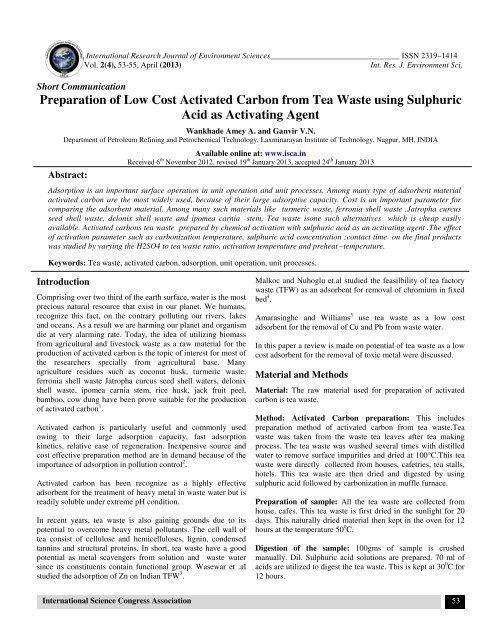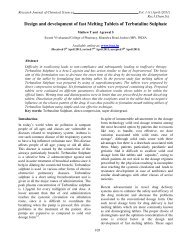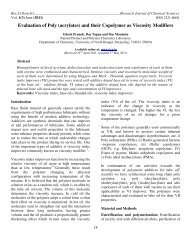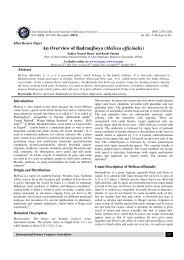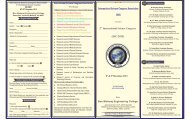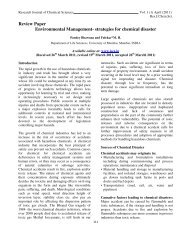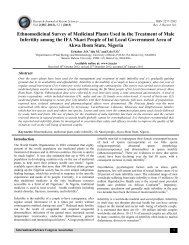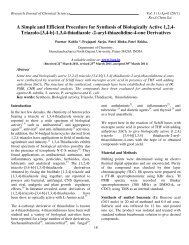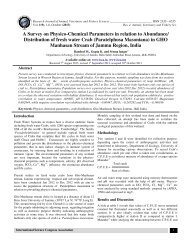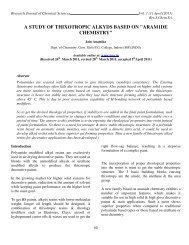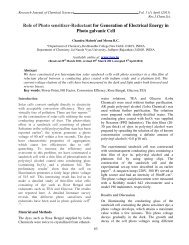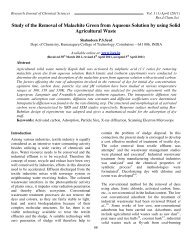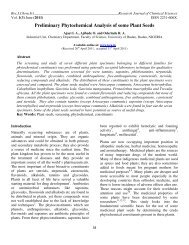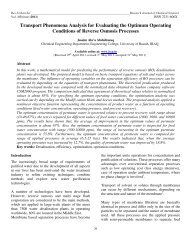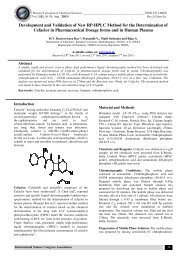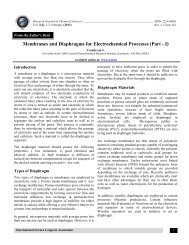Preparation of Low Cost Activated Carbon from Tea Waste ... - ISCA
Preparation of Low Cost Activated Carbon from Tea Waste ... - ISCA
Preparation of Low Cost Activated Carbon from Tea Waste ... - ISCA
Create successful ePaper yourself
Turn your PDF publications into a flip-book with our unique Google optimized e-Paper software.
International Research Journal <strong>of</strong> Environment Sciences________________________________ ISSN 2319–1414<br />
Vol. 2(4), 53-55, April (2013) Int. Res. J. Environment Sci.<br />
Short Communication<br />
<strong>Preparation</strong> <strong>of</strong> <strong>Low</strong> <strong>Cost</strong> <strong>Activated</strong> <strong>Carbon</strong> <strong>from</strong> <strong>Tea</strong> <strong>Waste</strong> using Sulphuric<br />
Acid as Activating Agent<br />
Wankhade Amey A. and Ganvir V.N.<br />
Department <strong>of</strong> Petroleum Refining and Petrochemical Technology, Laxminarayan Institute <strong>of</strong> Technology, Nagpur, MH, INDIA<br />
Abstract:<br />
Available online at: www.isca.in<br />
Received 6 th November 2012, revised 19 th January 2013, accepted 24 th January 2013<br />
Adsorption is an important surface operation in unit operation and unit processes. Among many type <strong>of</strong> adsorbent material<br />
activated carbon are the most widely used, because <strong>of</strong> their large adsorptive capacity. <strong>Cost</strong> is an important parameter for<br />
comparing the adsorbent material. Among many such materials like turmeric waste, ferronia shell waste ,Jatropha curcus<br />
seed shell waste, delonix shell waste and ipomea carnia stem, <strong>Tea</strong> waste isone such alternatives which is cheap easily<br />
available. <strong>Activated</strong> carbons tea waste prepared by chemical activation with sulphuric acid as an activating agent .The effect<br />
<strong>of</strong> activation parameter such as carbonization temperature, sulphuric acid concentration ;contact time on the final products<br />
was studied by varying the H2SO4 to tea waste ratio, activation temperature and preheat –temperature.<br />
Keywords: <strong>Tea</strong> waste, activated carbon, adsorption, unit operation, unit processes.<br />
Introduction<br />
Comprising over two third <strong>of</strong> the earth surface, water is the most<br />
precious natural resource that exist in our planet. We humans,<br />
recognize this fact, on the contrary polluting our rivers, lakes<br />
and oceans. As a result we are harming our planet and organism<br />
die at very alarming rate. Today, the idea <strong>of</strong> utilizing biomass<br />
<strong>from</strong> agricultural and livestock waste as a raw material for the<br />
production <strong>of</strong> activated carbon is the topic <strong>of</strong> interest for most <strong>of</strong><br />
the researchers specially <strong>from</strong> agricultural base. Many<br />
agriculture residues such as coconut husk, turmeric waste,<br />
ferronia shell waste Jatropha curcus seed shell waters, delonix<br />
shell waste, ipomea carnia stem, rice husk, jack fruit peel,<br />
bamboo, cow dung have been prove suitable for the production<br />
<strong>of</strong> activated carbon 1 .<br />
<strong>Activated</strong> carbon is particularly useful and commonly used<br />
owing to their large adsorption capacity, fast adsorption<br />
kinetics, relative ease <strong>of</strong> regeneration. Inexpensive source and<br />
cost effective preparation method are in demand because <strong>of</strong> the<br />
importance <strong>of</strong> adsorption in pollution control 2 .<br />
<strong>Activated</strong> carbon has been recognize as a highly effective<br />
adsorbent for the treatment <strong>of</strong> heavy metal in waste water but is<br />
readily soluble under extreme pH condition.<br />
In recent years, tea waste is also gaining grounds due to its<br />
potential to overcome heavy metal pollutants. The cell wall <strong>of</strong><br />
tea consist <strong>of</strong> cellulose and hemicelluloses, lignin, condensed<br />
tannins and structural proteins. In short, tea waste have a good<br />
potential as metal scavengers <strong>from</strong> solution and waste water<br />
since its constituents contain functional group. Wasewar et .al<br />
studied the adsorption <strong>of</strong> Zn on Indian TFW 3 .<br />
Malkoc and Nuhoglu et.al studied the feasilbility <strong>of</strong> tea factory<br />
waste (TFW) as an adsorbent for removal <strong>of</strong> chromium in fixed<br />
bed 4 .<br />
Amarasinghe and Williams 5 use tea waste as a low cost<br />
adsorbent for the removal <strong>of</strong> Cu and Pb <strong>from</strong> waste water.<br />
In this paper a review is made on potential <strong>of</strong> tea waste as a low<br />
cost adsorbent for the removal <strong>of</strong> toxic metal were discussed.<br />
Material and Methods<br />
Material: The raw material used for preparation <strong>of</strong> activated<br />
carbon is tea waste.<br />
Method: <strong>Activated</strong> <strong>Carbon</strong> preparation: This includes<br />
preparation method <strong>of</strong> activated carbon <strong>from</strong> tea waste.<strong>Tea</strong><br />
waste was taken <strong>from</strong> the waste tea leaves after tea making<br />
process. The tea waste was washed several times with distilled<br />
water to remove surface impurities and dried at 100°C.This tea<br />
waste were directly collected <strong>from</strong> houses, cafetries, tea stalls,<br />
hotels. This tea waste are then dried and digested by using<br />
sulphuric acid followed by carbonization in muffle furnace.<br />
<strong>Preparation</strong> <strong>of</strong> sample: All the tea waste are collected <strong>from</strong><br />
house, cafes. This tea waste is first dried in the sunlight for 20<br />
days. This naturally dried material then kept in the oven for 12<br />
hours at the temperature 50 0 C.<br />
Digestion <strong>of</strong> the sample: 100gms <strong>of</strong> sample is crushed<br />
manually. Dil. Sulphuric acid solutions are prepared. 70 ml <strong>of</strong><br />
acids are utilized to digest the tea waste. This is kept at 30 0 C for<br />
12 hours.<br />
International Science Congress Association 53
International Research Journal <strong>of</strong> Environment Sciences______________________________________________ ISSN 2319–1414<br />
Vol. 2(4), 53-55, April (2013) Int. Res. J. Environment Sci.<br />
Washing <strong>of</strong> the Digested sample: The digested tea waste were<br />
washed using distilled water, 10 to 12 washings were given.<br />
Determination <strong>of</strong> pH: The determination <strong>of</strong> pH <strong>of</strong> the<br />
carbonized material had been done.<br />
<strong>Carbon</strong>ization <strong>of</strong> the sample: The whole sample is taken in a<br />
container and kept at 500 0 C in muffle furnace for 15 minutes.<br />
Then oversize and undersize particle is separated by using 300<br />
meshes.<br />
Feed container: The feed container was a Crucible which could<br />
sustain temperature 500 0 C and above.<br />
Desiccators: The activated carbon was collected in air tight<br />
packets kept inside the desiccators. It keeps activated carbon<br />
moisture free.<br />
Sieving: The carbon obtain <strong>from</strong> above procedure was crushed<br />
manually and passed through the 300 mesh sieve plate to<br />
produce carbon <strong>of</strong> uniform size.<br />
Results and discussion<br />
The studies were carried out with potential adsorbent obtained<br />
<strong>from</strong> tea waste to evaluate its properties as an adsorbent.<br />
Counts<br />
300<br />
200<br />
100<br />
0<br />
<strong>Tea</strong><br />
The parameter chosen for the study and their variations on the<br />
adsorption are depicted in the following manner.<br />
The parameters are: carbonization temperature, pH <strong>of</strong> the<br />
adsorbent, XRD Analysis<br />
Effect <strong>of</strong> carbonization temperature: One <strong>of</strong> the most<br />
important parameter affecting the surface characteristics <strong>of</strong> the<br />
carbon is the carbonization temperature. The carbonization<br />
carried out at 400 0 C to 550 0 C. At 400ºC incomplete<br />
carbonization takes place, at 450ºC complete carbonization<br />
takes place and at 550 0 C the material gets converted into<br />
complete ash form while at remaining temperature carbon<br />
formation occurred. On sieve analysis two particle sizes<br />
obtained i.e. through and above 300 mesh sizes. It is observed<br />
that with the increasing temperature <strong>from</strong> 400 0 C to 550 0 C the<br />
tea waste get converted into carbon and nitrogen packing has<br />
been provided.<br />
The optimum carbonization temperature for the preparation <strong>of</strong><br />
the adsorbent was found to be 500 0 C. The results are shown for<br />
adsorbent with carbonization temperature 500 0 C.<br />
pH <strong>of</strong> the adsorbent: pH <strong>of</strong> the adsorbent is one <strong>of</strong> the most<br />
important factors as we treat the feed with acids and other<br />
chemicals therefore it is necessary to maintain the neutral pH.<br />
20 30 40 50 60 70 80 90<br />
Position [°2Theta] (Copper (Cu))<br />
Figure-1<br />
XRD <strong>of</strong> tea waste (Feed)<br />
International Science Congress Association 54
International Research Journal <strong>of</strong> Environment Sciences______________________________________________ ISSN 2319–1414<br />
Vol. 2(4), 53-55, April (2013) Int. Res. J. Environment Sci.<br />
C ounts<br />
300<br />
200<br />
100<br />
0<br />
W ankhede<br />
The above graph shows the phase change <strong>from</strong> amorphous to<br />
crystalline form by the change in peak height.<br />
Conclusion<br />
The activated carbon prepared at carbonization temperature<br />
500 0 C, carbonization time 15 mins and sulphuric acid as an<br />
activating agent gives the good surface area and also shows the<br />
crystalline phase in the activated carbon.<br />
Reference<br />
1. Jun T.Y, Arumugam S.D, Latip N.H.A , Abdulla A. M and<br />
Latif P. A, Effect <strong>of</strong> Activation Temperature and Heating<br />
Duration on Physical Characteristics <strong>of</strong> <strong>Activated</strong> <strong>Carbon</strong><br />
Prepared <strong>from</strong> Agriculture <strong>Waste</strong>, Environment Asia3<br />
(special issue),143-148 (2010)<br />
2. Hu Z and Srinivasan M.P, <strong>Preparation</strong> <strong>of</strong> High-Surface-<br />
20 3 0 40 50 60 7 0 80 90<br />
P osition [°2Theta] (C op per (C u))<br />
Figure-2<br />
XRD <strong>of</strong> Product activated carbon(tea waste)<br />
Area <strong>Activated</strong> <strong>Carbon</strong> <strong>from</strong> Coconut Shell, Microporous<br />
and Mesoporous materials, 27, 11-18 (1999)<br />
3. Wasewar K.L., Adsorption <strong>of</strong> Metals onto <strong>Tea</strong> Factory<br />
<strong>Waste</strong> <strong>Waste</strong>: A Review, International Journal <strong>of</strong><br />
Research and Reviews in Applied Science, 3(3), 303-322<br />
(2010)<br />
4. Malkoc E and Nuhoglu Y, Fixed Bed Studies for the<br />
Sorption <strong>of</strong> Chromium (iv) on <strong>Tea</strong> Factory waste, Chem.<br />
Eng. Sci., 16, 4363-4372 (2006)<br />
5. Amarasinghe BMWPK and Williams A.R., <strong>Tea</strong> <strong>Waste</strong> As a<br />
<strong>Low</strong> <strong>Cost</strong> Adsorbent for the Removal <strong>of</strong> Cu and Pb, <strong>from</strong><br />
<strong>Waste</strong> Water, Chem. Eng. J, 132, 299-309(2007)<br />
6. Ganvir V.N., Meshram M.L. and Dwivedi A.P., <strong>Preparation</strong><br />
<strong>of</strong> Adsorbent <strong>from</strong> Karanja Oil Seed Cake and Its<br />
Characterization, International Conference on Emerging<br />
Frontiers in Technology for Rural Area, 3, 18-19 (2012)<br />
International Science Congress Association 55


